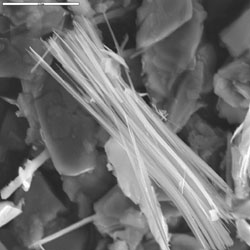“Home inspections.. with absolute character and integrity.”
Asbestos in your home
Why Do You Need to be Concerned About Asbestos?Asbestos is a mineral fiber that has been used commonly in a variety of building construction materials for insulation and as a fire-retardant. Because of its fiber strength and heat resistant properties, asbestos has been used for a wide range of manufactured goods, mostly in building materials: roofing shingles, ceiling and floor tiles, paper products, insulation and asbestos cement products. These products are found in many of our homes built prior to 1970’s.

Tremolite Asbestos (Image Source: U.S. Geological Survey)
When asbestos-containing materials are damaged or disturbed by repair, remodeling or demolition activities, microscopic fibers become airborne and can be inhaled into the lungs, where they can cause significant health problems. Breathing high levels of asbestos fibers can lead to an increased risk of lung cancer, mesothelioma: a cancer of the lining of the chest and the abdominal cavity, and asbestosis, in which the lungs become scarred with fibrous tissue. The symptoms of these diseases do not usually appear until about 20 to 30 years after the first exposure to asbestos.
Most people exposed to small amounts of asbestos, as we all are in our daily lives, do not develop these health problems. However, if disturbed, asbestos material may release asbestos fibers, which can be inhaled into the lungs. The fibers can remain there for a long time, increasing the risk of disease. Asbestos material that would crumble easily if handled, or that has been sawed, scraped, or sanded into a powder, is more likely to create a health hazard.
What Should Be Done About Asbestos In The Home?If you think asbestos may be in your home, don’t panic. Usually the best thing is to leave asbestos material that is in good condition alone. Generally, material in good condition will not release asbestos fibers.
Check material regularly if you suspect it may contain asbestos. Don’t touch it, but look for signs of wear or damage such as tears, abrasions, or water damage. Damaged material may release asbestos fibers. This is particularly true if you often disturb it by hitting, rubbing, or handling it, or if it is exposed to extreme vibration or air flow.
Sometimes the best way to deal with slightly damaged material is to limit access to the area and not touch or disturb it. Check with local health, environmental, or other appropriate officials to find out proper handling and disposal procedures.
If asbestos material is more than slightly damaged, or if you are going to make changes in your home that might disturb it, repair or removal by a professional is needed. Before you have your house remodeled, find out whether asbestos materials are present.
How To Identify Materials That Contain AsbestosYou can’t tell whether a material contains asbestos simply by looking at it, unless it is labeled. If in doubt, treat the material as if it contains asbestos or have it sampled and analyzed by a qualified professional. A professional should take samples for analysis, since a professional knows what to look for, and because there may be an increased health risk if fibers are released. In fact, if done incorrectly, sampling can be more hazardous than leaving the material alone. Taking samples yourself is not recommended. Material that is in good condition and will not be disturbed (by remodeling, for example) should be left alone. Only material that is damaged or will be disturbed should be sampled.
